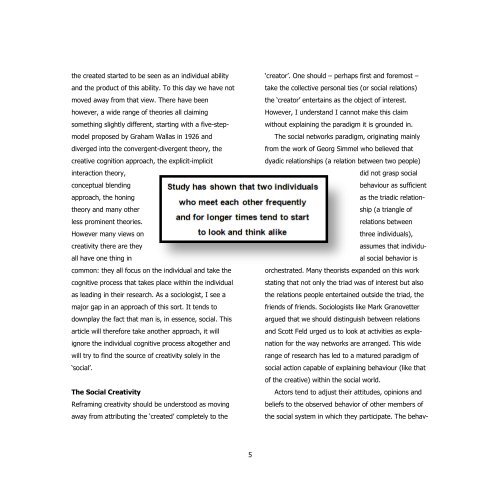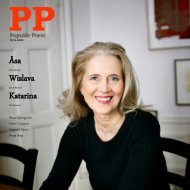Nr 15 Kreativitet: PDF-version - Populär Poesi
Nr 15 Kreativitet: PDF-version - Populär Poesi
Nr 15 Kreativitet: PDF-version - Populär Poesi
Create successful ePaper yourself
Turn your PDF publications into a flip-book with our unique Google optimized e-Paper software.
the created started to be seen as an individual ability<br />
and the product of this ability. To this day we have not<br />
moved away from that view. There have been<br />
however, a wide range of theories all claiming<br />
something slightly different, starting with a five-step-<br />
model proposed by Graham Wallas in 1926 and<br />
diverged into the convergent-divergent theory, the<br />
creative cognition approach, the explicit-implicit<br />
interaction theory,<br />
conceptual blending<br />
approach, the honing<br />
theory and many other<br />
less prominent theories.<br />
However many views on<br />
creativity there are they<br />
all have one thing in<br />
common: they all focus on the individual and take the<br />
cognitive process that takes place within the individual<br />
as leading in their research. As a sociologist, I see a<br />
major gap in an approach of this sort. It tends to<br />
downplay the fact that man is, in essence, social. This<br />
article will therefore take another approach, it will<br />
ignore the individual cognitive process altogether and<br />
will try to find the source of creativity solely in the<br />
‘social’.<br />
The Social Creativity<br />
Reframing creativity should be understood as moving<br />
away from attributing the ‘created’ completely to the<br />
5<br />
‘creator’. One should – perhaps first and foremost –<br />
take the collective personal ties (or social relations)<br />
the ‘creator’ entertains as the object of interest.<br />
However, I understand I cannot make this claim<br />
without explaining the paradigm it is grounded in.<br />
The social networks paradigm, originating mainly<br />
from the work of Georg Simmel who believed that<br />
dyadic relationships (a relation between two people)<br />
did not grasp social<br />
behaviour as sufficient<br />
as the triadic relation-<br />
ship (a triangle of<br />
relations between<br />
three individuals),<br />
assumes that individu-<br />
al social behavior is<br />
orchestrated. Many theorists expanded on this work<br />
stating that not only the triad was of interest but also<br />
the relations people entertained outside the triad, the<br />
friends of friends. Sociologists like Mark Granovetter<br />
argued that we should distinguish between relations<br />
and Scott Feld urged us to look at activities as expla-<br />
nation for the way networks are arranged. This wide<br />
range of research has led to a matured paradigm of<br />
social action capable of explaining behaviour (like that<br />
of the creative) within the social world.<br />
Actors tend to adjust their attitudes, opinions and<br />
beliefs to the observed behavior of other members of<br />
the social system in which they participate. The behav-



